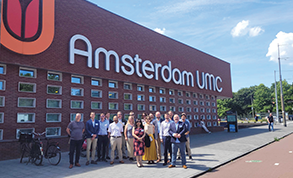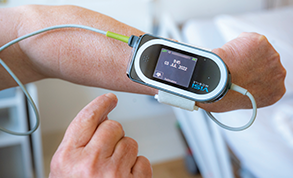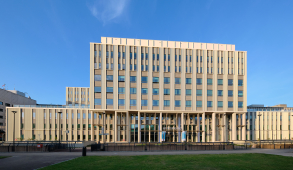Feature / Going Dutch
It can be hard to draw comparisons from different health systems even when they face very similar challenges. But recent delegates on an HFMA study tour to the Netherlands saw benefits in how the Dutch health services have clarity over who delivers what services and the transparency around healthcare costs.
The tour, supported by LOGEX Healthcare Analytics, gave a number of finance leaders and a chief medical officer a whistlestop tour of two leading teaching hospitals in the Netherlands. It also provided some time out of the office to reflect on different approaches to healthcare delivery and whether innovative practices could be relevant to the NHS.
The two hospitals visited – Amsterdam University Medical Centers and Radboud University Medical Centre in Nijmegen – are specialist tertiary centres that undertake significant amounts of research and provide training for healthcare professionals. Both boast impressive, modern facilities.
Tour delegates were struck by the clear demarcation between different parts of the health service. Both hospitals focus solely on complex tertiary care, research and teaching. Very strict gatekeeping, starting in primary care, aims to keep less complex activity in general hospitals, with referrals needed for patients to access each sector.
‘There is real clarity in the Dutch system about what tier a healthcare organisation is working in,’ said Lee Outhwaite, chief finance officer at South Yorkshire Integrated Care Board. ‘There is a clear-cut tertiary centre, secondary, community and primary care.’
This clear separation of roles was significant in the country’s response to Covid. Paul Antunes-Goncalves, acting director of finance at Nottingham University Hospitals NHS Trust, stressed the point. ‘The impact of Covid in the Netherlands system, particularly in the specialist teaching hospitals, was a lot lower in terms of productivity,’ he said. In the NHS, with specialist hospitals undertaking more general healthcare, Covid was more disruptive.
Kiran Patel, chief medical officer at University Hospitals Coventry and Warwickshire NHS Trust, described the Dutch system as having more focus and being ‘more ruthless’ in defining boundaries. ‘Focus in the sense that each organisation knows exactly what its business is and it doesn’t venture beyond that,’ he said.
Professor Patel highlighted the benefits of the Amsterdam hospital’s complete attention on tertiary care, teaching and research. ‘It accepts that it needs to devolve lower levels of acuity of care into the district general hospital setting or into the primary care setting and perhaps we don’t do that as well in the NHS in England,’ he said. ‘We are not clear about where our boundaries of responsibility and accountability lie, we often absorb everything and that’s often because patients come where the lightbulbs are on.’
However, UK delegates on the tour wondered whether the clearer separation between parts of the system might in some cases inhibit attempts to integrate services around patients and across organisational boundaries. Mr Antunes-Goncalves suggested that a tiered system, as exists in the Netherlands, would need very good communication channels to support integration.
In practice, Holland operates a hub structure where general hospitals form a network around each teaching hospital, with regular dialogue and team meetings to discuss cases.
Prevention incentives
He also wondered how the Dutch system incentivised investment in prevention, given funding was linked to the delivery of activities and not to population wellbeing as a whole. However, according to the European Health Observatory, the Netherlands actually has among the highest levels of spending on prevention in the European Union.
The Dutch system continues to use a tariff-based payment system for hospital care, based on diagnosis-related groupings (DRGs). In part, the English NHS has moved away from its tariff system because of concerns that it incentivises increased activity in secondary care and does not support a pathway view of the best place to deliver care. Earlier intervention or prevention may offer the better solution to improved outcomes and cost, rather than increasing secondary care capacity or improving hospital productivity.
Mr Antunes-Goncalves acknowledged both the hospitals visited were focusing on aspects of prevention. But it was not clear that the financial reimbursement mechanism directly supported it. ‘I wonder how the insurance market is going to have to adapt for the move to prevention,’ he said. This was particularly challenging given the workforce shortages that faced all health systems and the potential reduced mobility of staff in the more clearly demarcated Dutch system.
Huw Thomas, chief finance officer of Hywel Dda University Health Board, said all systems were looking for ways to take a more holistic view of patient care. ‘In Wales, we have a population health system, and we are responsible for the population as a whole, not just treating people when they are unwell,’ he said. ‘That bringing together of public health, prevention and delivery of healthcare I think gives a very different model.’
Healthcare in the Netherlands uses a different funding mechanism to the NHS. In the NHS, healthcare is basically delivered by public organisations, funded by the government. The Netherlands also provides largely universal health coverage underpinned by an insurance model. A social health insurance system covers core services, with all residents required to purchase insurance policies covering a defined benefits package set by the government. Insurers are required to accept all applicants and then contract with not-for-profit providers for the delivery of services. There are separate funding arrangements for long-term care and for social care, with municipalities having a bigger role.
There is also an element of cost sharing with patients through an excess (or deductible) of around £325 per year.
The contracting framework appears complex, with insurers negotiating most rates with providers, some tariffs set nationally and add-on payments direct from government. However, delegates on the study tour mostly liked the way patients were informed of the costs of care even though costs were largely covered by the insurance companies.
Robbie Chapman, deputy chief financial officer at Wirral University Teaching Hospital NHS Foundation Trust, said the cost visibility helped with the engagement of the population. ‘People understand [the costs of services] through their insurance premiums and the excess they pay for initial treatment – and that can incentivise better behaviours and prevent people from presenting with issues that they don’t need to see doctors for,’ he said.
Dominic Thornton, deputy director of finance at Nottingham University Hospitals NHS Trust, also highlighted the fact that patients receive a receipt for the full costs of treatment, though the bulk of the costs are met from insurance. ‘Healthcare that is free at the point of delivery in the UK can create the possibility that people feel entitled to it and don’t always take responsibility for it,’ he said.
While the public are generally very supportive and appreciative of the NHS, a better understanding of the costs of care could reinforce calls to access care in the most appropriate setting.
Insurance model concerns
Some delegates wondered if the insurance model – with the ability to top up core policies for additional coverage and the use of excess payments – might exacerbate inequalities.
University Hospitals Coventry and Warwickshire NHS Trust chief finance officer Su Rollason said she continued to have concerns about insurance-based systems. ‘There are potential benefits to having a tightly defined minimum package of care, but it really depends on the depth of that package,’ she said. ‘If some aspects of care are covered by paying a higher premium, there is the danger of an inequitable situation, which could make the difference to being able to get back to work or look after your family.’
Brian Shipley, deputy chief finance officer of Northern Lincolnshire and Goole NHS Foundation Trust said the tour had also highlighted cultural differences and different attitudes to healthcare in the two countries.
‘In the Netherlands, there is a cap on the level of care [determined by the government-set defined benefits covered in the mandatory insurance package],’ he said. ‘That just does not happen in the UK, where it is a tap that just keeps running.’
Returning to the subject of tertiary hospitals, Mr Shipley backed the idea of specialist centres of excellence. This can make the best use of scarce staffing resources and ensure clinicians see the right number of cases to keep their skills sharp. But it was not the solution for all types of care and there could be other issues that could be taken into account, such as ease of access. ‘Trying to get everyone to specialise in certain things … might mean patients having to travel further in many cases, and that is difficult culturally in the UK.’
Overall, participants hailed the study tour a success and a valuable experience. Mr Thomas, summed it up. ‘The fundamental conundrum affecting all developed countries is how we continue to provide health and care with good outcomes to an ageing population with constraints in our workforce,’ he said. ‘How we all respond to that will be different, and in those differences exists a rich learning opportunity for us all.’
Smart building
Radboud UMC is one of the largest hospitals in the Netherlands, providing tertiary care for people living in the east of the country. Located in Nijmegen, the specialist centre handles more than 22,000 admissions a year and treats some 180,000 patients. It also majors in research and, at any one time, is training more than 3,000 students.
In July, it opened its new main building. More compact and flexible, this reduces the hospital’s environmental footprint, with single rooms giving patients greater privacy and the use of smart technology providing benefits for patients and staff.
The entire campus now takes up 20% less space and makes more intensive use of its estate, although there are plenty of green spaces outside for patients and visitors to use whenever possible. The new building also makes extensive use of smart technology. Patients can use a tablet to digitally control the curtains, temperature and position of the bed. Other smart features include special ‘care’ telephones, digital door signs and intelligent care and call systems for the patient and care provider. Alarms and calls are immediately directed to the right care provider.
Sustainability was an important aspect of the design, with glass facades, floors and roofs extra insulated to achieve the lowest possible energy consumption. Sustainable power is provided by solar cells and wind turbines and thermal storage helps to regulate the hospital temperature. Taken together, the measures have earned the hospital an excellent rating under the BREEAM sustainability assessment scheme.
Related content
The value masterclass shares examples of organisations and systems that have pursued a value-driven approach and the results they have achieved.
This webinar series offers colleagues of ICS organisations the opportunity to discuss common priorities, challenges, and successes within their field.